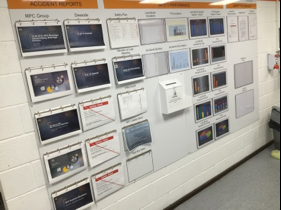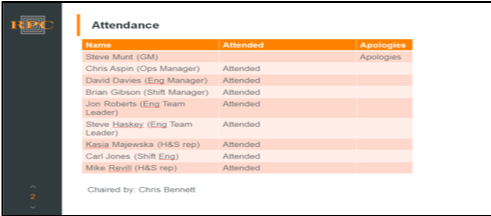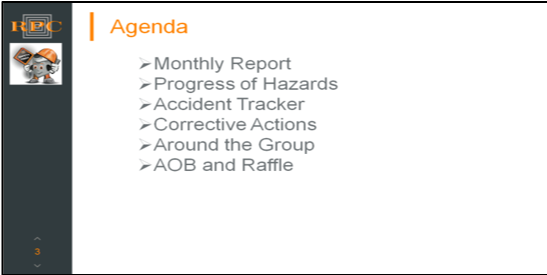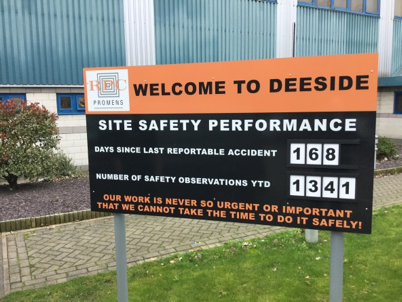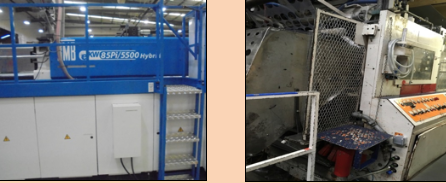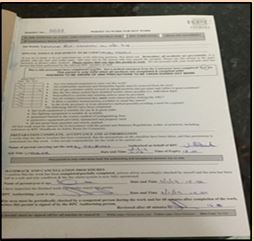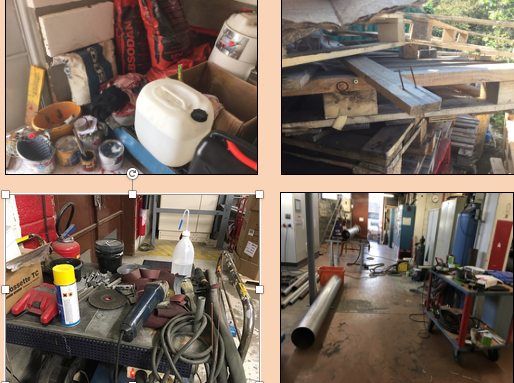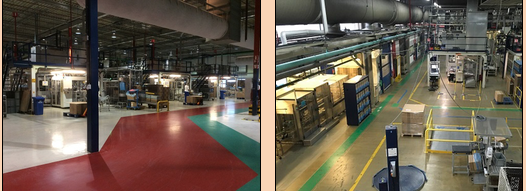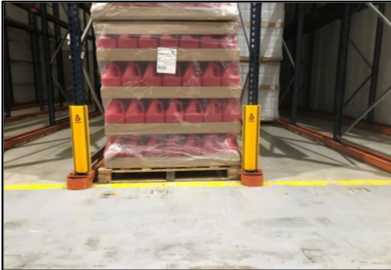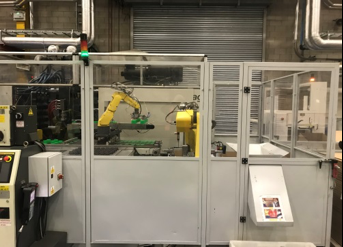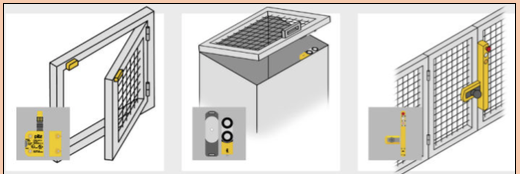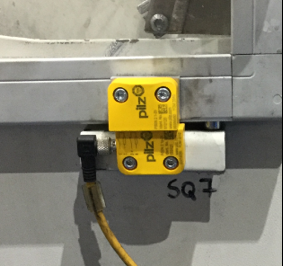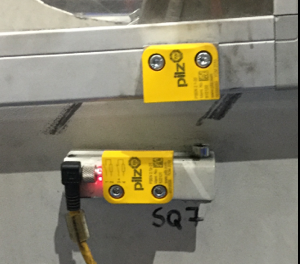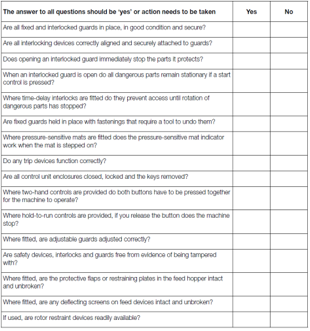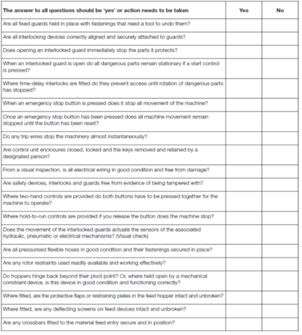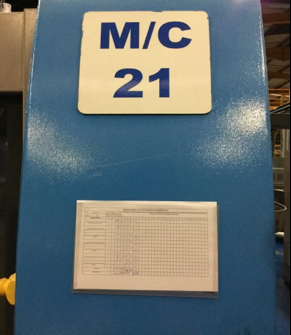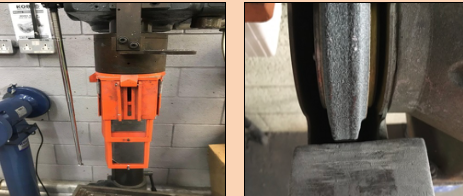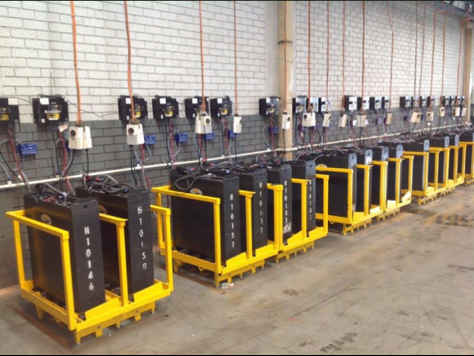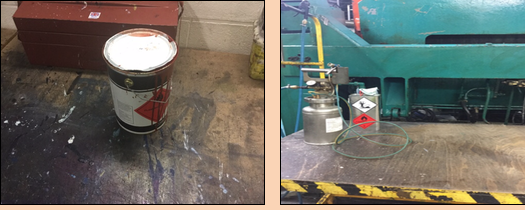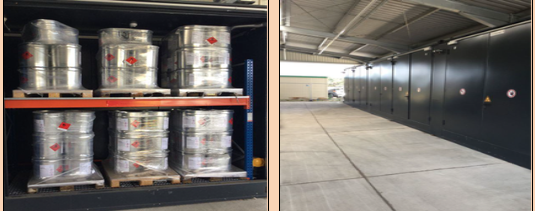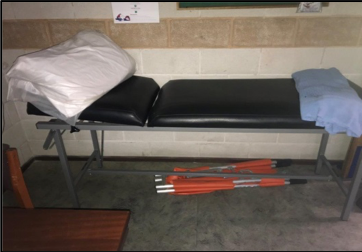Title Page
-
Site conducted
-
Add site photo
-
Conducted on
-
Prepared by
-
Location
-
Particpants
Element 1 – Leadership & Accountability
1.1 H&S Policy
-
Environment, health and safety policy is current and signed by senior management.<br><br>The policy is effectively communicated through noticeboards and secondary means (e.g. induction, team meetings).
-
Show guidance
-
All Berry CPI sites must display the group health and safety policy (signed by the CEO) in prominent areas (e.g. reception, employee noticeboard). Berry CPI requires that a localised policy is created which should include a declaration by executive site management emphasising the importance of safety to the operation. The policy must be effectively communicated not only through placing on noticeboards but also through secondary means such as induction training or employee handbooks.
-
• Photograph shows safety noticeboard with policy and site information
Element 2 - Employee Engagement and Behavioural Safety
2.1 Safety Committee
-
A Health and Safety Committee (or dedicated health and safety meeting) is in place which consists of senior management, line management, shop floor and representation from all departments.
-
Show guidance
-
The site should have a defined health and safety committee including all areas of the business. The committee should document and evidence participation from all levels within the committee. Shop floor representation is key to this.
-
• Photograph shows an example safety committee attendance register.
2.2 Safety Committee Meetings
-
Safety committee meetings (or similar forums e.g. management safety meetings) held at least 11 of the last 12 months.<br><br>A formal agenda is in place for the meetings. Records of the meetings are retained and distributed. Minutes of the meeting are placed on noticeboards. <br><br>Completion of actions is to a reasonable timescale.
-
Show guidance
-
The safety committee meeting forum should be held at a monthly frequency, defined agenda and minutes should be created to formally evidence the meeting.
-
• Photograph shows safety committee meeting agenda
2.4 Visible Safety Signage through site
-
Clear visible safety signage is in place externally as you enter the site. <br><br>Days since the last recordable accident is displayed. <br><br>Berry CPI safety principles and safety policy are displayed.
-
Show guidance
-
When you approach a Berry CPI site, it should be clear that safety is important at the site. Some form of signage outside the building should be in place. In addition, the site should display the days since the last recordable accident and the Berry CPI principles.
• Photograph site safety performance displayed at entrance.
Element 4 - Risk Management and Higher Risk Tasks
4.3 Quality of risk assessments
-
Risk assessments completed are detailed and robust. The risk assessments process identifies all related hazards, conducts an evaluation of the risk and identifies further controls where necessary.
-
Show guidance
-
Risk assessments should be comprehensive and completed to a good standard. Risk assessments should identify all potential hazards with the machine, process or tasks; conduct an evaluation of the risk (e.g. risk rating system) and identify further controls where necessary. The quality of risk assessments completed will be evaluated and graded by the auditor. If sites are unsure about the quality of their assessments it is advisable they communicate with other parts of the business to obtain samples of good practice.
4.4 Risk Assessments & Employee Involvement
-
Operational staff are primarily responsible for conducting risk assessments. <br><br>Relevant people involved (i.e. those involved in tasks) in the assessment process (All persons involved must be documented on assessment).<br><br>(Note: External companies should only be utilised for specialist areas e.g. chemicals, noise, asbestos).
-
Show guidance
-
It is important that the risk assessment process is owned and managed by the facility and not by an external third party consultant. Operational staff should be primarily responsible for conducting risk assessments with the support of others (e.g. shift supervisor, operator, engineer, safety officer etc). External companies should only be used for risk assessments if there is a specialist need for them (e.g. asbestos, air monitoring). Sites that rely totally on external expertise for risk assessment will score RED in this section.
4.11 Higher Risk Operations - Work at Height Risk Assessments and Safe System of Work
-
The site has identified all (foreseeable) work at height activities (e.g. roof work, work on top of machines, repairing / maintaining lights, racking, pipework etc).<br>The auditor should review the work at height activities that have been identified to ensure it is adequate.<br><br>There are risk assessments and safe systems of work written for all identified work at height activities.<br><br>The auditor should review 1 risk assessment and 1 safe system of work related to work at height.
-
Show guidance
-
Risk assessments should be comprehensive and completed to a good standard. Risk assessments should identify all potential hazards linked with the work at height (must include equipment and tasks associated with the work). The risk assessment must evaluate the risk level (e.g. risk rating system) and identify further controls where necessary. The quality of risk assessments completed will be evaluated and graded by the auditor. If sites are unsure about the quality of their assessments, it is advisable they communicate with other parts of the business to obtain samples of good practice.
The auditor should check the site have identified all work at height activities. Risk assessments should be completed for each one.
The assessment process should identify controls which are necessary for the task to be completed. When deciding on controls it is important to consider the complexity and duration of the task. Examples of controls are:
• Avoidance of work at height (e.g. gutter clearance using ground operated suction equipment)
• Prevention of falls (e.g. fitting guard rails, use of access equipment)
• Minimising the consequences (e.g. using fall arrest equipment such as a harness)
Ladder work should be avoided wherever possible particularly for non one-off tasks.
Training records should be checked by the auditor e.g. use of a ladder, use of a MEWP, use of a safety harness.
All work above ground level is classed as working at height.
• Photograph shows work platform with fixed ladders, flick gate and edge protected work area. Second photograph shows unsuitable access step.
4.15 Higher Risk Operations – Permits to Work Needs Analysis
-
The site has used a systematic approach to identify the need for ‘Permits to work’ for certain higher risk activities.
-
Show guidance
-
In order to properly identify the need for Permits to Work, the site needs take a systematic approach such as a survey of the site, a review of all tasks, review of all occupations / roles, reviews of risk assessments, employee involvement etc.<br><br>With this information, the site should be able to determine what Permits to Work systems it needs. Examples include:<br>• Work at Height<br>• Confined space entry<br>• Hot work **<br>• Work with energy sources (such as electricity)<br>• Major lifts / hoists<br>• Excavation permits<br>The auditor should check that the site has carried out thorough reviews to determine its permit needs. The auditor should ensure that the site has properly identified its permit needs. The auditor should not accept ‘not applicable’ for permits such as ‘Work at Height’, ‘Major Lifts / Hoists’, ‘Hot Work’ and ‘Work with energy sources’ as these high hazard activities are almost certainly possible at all sites at some point in time.<br><br>**NOTE – hot work permits are not required when hot work is conducted in a designated area such as a welding bay (assuming the welding bay is set up safely i.e. clear of combustibles, fire extinguisher to hand etc).
4.16 Higher Risk Operations – Permits to Work Systems
-
The site has developed permit systems for each of the high hazard activities identified above.<br><br>Each permit system has the following features:<br><br>• Formal issuing system<br>• Issuing authority is specified.<br>• Permit issuers trained.<br>• Employees at risk trained.<br>• Training records maintained.<br>• Permit copies retained.<br>• Permits are used for hazardous activities undertaken by Berry personnel and contractors alike.
-
Show guidance
-
• The system to issue permits must be explained in writing and must include procedures and conditions for issuing the work permit. The system should describe methods to obtain permits during both normal and late or unusual shift operating hours.
• The written system for issuing work permits must specify the personnel in the organisation who have the authority to issue each type of permit.
• Each person who has the responsibility for issuing work permits must be formally trained prior to being allowed to issue work permits. The training must be formal and must cover the following:
o The situations requiring the use of permits
o The permit issuing procedures, including the forms and signatures required and records to be kept.
o Special precautions which must be followed for the type of work which the permit is issued.
o Procedures for the use of specialised equipment required by the issuing permits(s) such as explosive atmosphere monitor, oxygen level meters etc.
• Employees who are involved in work requiring work permits must also receive formal training regarding the permit system. Employee training should include the following:
o Work requiring the issue of work permits.
o How to initiate a request for a permit.
o Special conditions which may require permit renewal (a shift change etc).
o Required precautions for work involving permits.
• Written records should be kept of each individual trained, the training received and the date(s) of training and retraining.
• A written record of all permits issued should be kept.
Element 5 – Incident Reporting and Investigation
5.1 Effectiveness of hazard and near-miss reporting
-
Hazard and near-miss reporting is robust, well-integrated and the workforce are fully engaged in the process.<br><br>Sites should be aiming for 6 hazard reports per person each year.<br><br>(Note: these should be actual hazard reports and not purely maintenance requests).
-
Show guidance
-
In addition to measuring the number of hazard and near-miss reports in relation to employee numbers, the auditor must also ensure the hazard and near-miss reports are safety-related and not maintenance requests. The auditor should check the source of the reports to ensure they are not all created by management. Shop floor employees must be fully engaged to achieve BLUE. Accidents are effectively any unplanned event that results in injury or ill-health to people, or damages equipment, property or materials. Every accident must be reported and recorded no matter how minor the severity or injury. A Near Miss is an event or situation that could have resulted in injury, damage or loss. A hazard can be any circumstance that has the potential to cause harm. Hazards will always exist in our workplace to a certain extent and we must be able to recognise these to remove them to prevent it causing an incident. A hazard can be almost anything and is not just restricted to obvious physical issues such as a trailing lead, damaged guard or a blocked fire exit. A hazard could be unsafe behaviours or acts. Therefore we need to ensure that we record and highlight unsafe acts and behaviours in order for us to take remedial action and prevent an incident occurring. All sites must have a formal system for hazard and near-miss reporting in place. To supplement this ALL employees must have received training and instruction in what they should report and how. Auditors will need to see clear documented evidence that systems are in place and the training has been conducted.
Element 7 - Housekeeping and 5S
7.2 Housekeeping Programme
-
A formal housekeeping programme has been implemented (e.g. 5s system).
-
Show guidance
-
The auditor should primarily review the housekeeping standards through the site tour. This will ultimately determine the grade awarded. The grade will come down to the auditor's judgement on what they see during the day.
7.3 Maintenance /Engineering / Toolrooms - Housekeeping
-
Housekeeping is to a high standard and a 5s system is in place.<br>(i.e. good storage and organisation of equipment and consumables, aisles clear, cleanliness, no trip hazards, chemicals, oils, aerosols etc.)
-
Show guidance
-
• Photograph shows poor housekeeping internally and externally.
-
• Photographs shows good housekeeping standards.
Element 8 – Training and Communications
8.2 Identification of Employee Training Programmes
-
A systematic approach is in place to identify employee's training needs (risk assessment, safe systems of work, loss history, legislation etc is used to identify needs).<br><br>Programme is documented (e.g. using training matrix).
-
Show guidance
-
The site must demonstrate they have a formal process in place to identify, deliver and monitor health and safety-related training. This is normally in the form of a training matrix.
• Photograph shows training matrix with employee and task tracker.
Element 11 - Equipment Inspections and Preventative Maintenance
11.4 Storage & Racking
-
Storage arrangements are suitable (e.g. block stacked products) and racking in sound condition. <br><br>Adequate protection of racking uprights provided.<br><br>Formal (documented) checks of racking MUST be completed quarterly and defects remedied.
-
Show guidance
-
• Photograph shows palletised storage racking with protection and floor markings
Element 12 - Hazardous Energy Control
12.5 Electricity Cabinets
-
All electrical cabinets must be closed and locked.
-
Show guidance
-
All electrical cabinets across the site must be locked to prevent unauthorised, unqualified or untrained persons accessing electricity. A person can demonstrate competence to perform electrical work if they have successfully completed an assessed training course, run by an accredited training organisation that included the type of work being considered. As part of that course, this person should have demonstrated an ability to understand electrical theory and put this into practice. Consumer units (RCD Switch Panels) do not require isolation, as long as all switches are in place and the cover panel is adequately secured. In the event that a circuit is isolated in order for work to be carried out, then this should be locked off so that power cannot be applied.
Electrical panels locked with both hasp and staple and secured locking mechanism
Element 13 - Machine Guarding
13.1 Fixed Guarding Direct Access (Access to Dangerous Parts)
-
All fixed guarding must be in place, in good condition and held in place with fastenings that require a tool to undo them.
-
Show guidance
-
Fixed Guarding - A fixed guard is part of a machine that guarantees protection by means of a physical barrier. The guard may consist of a safety fence, barrier, covers or similar. Fixed guards make it more difficult to access the machine physically. Fixed guards must be fixed by systems that can be opened or removed only with tools. Where possible, guards must be incapable of remaining in place without their fixings.
-
Fixed guarding around Robot
13.2 Guarding Issues (Deterioration, screws missing, poor state)
-
All guarding free of deterioration, missing screws and in a good state.
13.3 Non-Fixed Interlocking Guards
-
All non-fixed interlocking guards must be in place and in good condition.<br><br>All non-fixed interlocking guards must be connected mechanically to the machine frame or to a fixed part. (Guards may be hinged or railed)<br><br>Opening a non-fixed interlocked guard immediately stops the equipment it protects.
-
Show guidance
-
Non-fixed interlocked guards are a practical way to prevent access to the dangerous rotating/moving parts where access to the tooling etc is occasionally needed during the work process. Non-fixed guards must be connected mechanically to the machine frame or to a fixed part close to the machine. The guard may be hinged or rail-mounted that can be opened without using a specific tool and are only effective when they are closed. Non-fixed guards are associated with interlocking devices and when opened the interlocking device ensure that all hazardous functions are stopped and an unexpected restart is reliably prevented.
Auditor to select 3 random machines to observe that all safety devices are in good condition and fully functional. -
Live example - Guard closed with interlock engaged and correctly aligned.
-
Live example - Guard open with Interlock disengaged in order to prevent hazardous movement.
13.6 Machine Guarding - Pre-use Checks (Granulators and Ancillary equipment to be included)
-
Employees must carry out visual guard inspections every shift. These must be documented. This is to ensure hazardous areas cannot be accessed.<br><br>All inspection documents must be available at machine point.
-
Show guidance
-
Guard Inspections – Guard inspections must be carried out by employees on every shift with any defective guarding documented and repaired immediately.
Ancillary equipment E.g. Stretch Wrap Machines, Pick and Place Robots, etc. must be included within the guarding inspections.
Fixed Guarding - A fixed guard is part of a machine that guarantees protection by means of a physical barrier. The guard may consist of a safety fence, barrier, covers or similar. Fixed guards make it more difficult to access the machine physically. Fixed guards must be fixed by systems that can be opened or removed only with tools. Where possible, guards must be incapable of remaining in place without their fixings. -
Operator Checks (Granulators)
-
Monthly Checks (Granulators)
-
Guard Inspection at Machine Point (Granulators)
-
Fixed guarding around Robot
13.10 Maintenance / Engineering / Toolroom Machine Guarding
-
Suitable machine guards in place for all fixed equipment in the maintenance / engineering room.
-
Show guidance
-
Suitable guarding should be present on all equipment. This includes chuck guards to lathes and fixed guarding to grinder and pillar drills as examples.
• Photograph shows maintenance room drill with flick guard and incorrectly used grinding wheel.
Element 14 - Emergency Preparedness & Fire Prevention
14.6 Evacuation Drills
-
Evacuation drills are conducted at least once per year and cover all shifts.
14.9 Battery Charging Areas
-
The battery charging area is a dedicated area<br><br>The area is kept free of combustible material (at least 2 metres clearance to combustible materials).<br><br>The area is covered by an automatic fire detection system and is appropriately ventilated.<br><br>Charging is separated from composite/sandwich panels, which contain combustible insulation, by a fire-wall rated at 2 hours.
-
Show guidance
-
• Photograph shows good practice battery charging area.
Element 15 - Control of Hazardous Substances
15.2 Control of Hazardous Substances
-
Control measures are in place for emissions, handling, storage, use and disposal of hazardous substances. This should include extraction, ventilation, explosion control, containment and earthing where appropriate. <br><br>Emergency arrangements are appropriate and local to use (e.g. emergency shower). <br><br>All containers are suitably labelled.<br><br>Suitable bunds are used.
-
Show guidance
-
Photographs – Shows poor chemical storage.
-
Photograph – Shows good practice storage areas.
15.4 Asbestos
-
Assessments for the presence and condition of asbestos are formally completed.<br><br>A formal management plan in place for controlling asbestos work.
-
Show guidance
-
The site should have an asbestos survey in place, outlining the location of asbestos-containing materials. The survey should be part of the 'Asbestos Management Plan'. The Asbestos Management Plan should demonstrate how asbestos information is communicated to applicable parties such as contractors and employees and also detail how asbestos on site is being identified/managed/inspected etc.
Evidence should also be provided of on-going monitoring of asbestos materials.
Element 18 – Health and Wellness
18.1 First Aid Programme
-
The first aid programme is formalised, implemented and includes sufficient resources (i.e. trained personnel, materials, facilities).
-
Show guidance
-
All Berry CPI sites should have arrangements for the following:
• A suitable number of trained first aid personnel (training should be provided by a recognised training company e.g. government approved).
• Adequate first aid materials (amount, type, accessibility).
• Suitable rest facilities (suitable rest facilities should be available for an injured employee e.g. first aid room).
• Established written arrangements for emergency services contact.
• Photograph shows site first aid facilities.
18.4 Noise Level Survey
-
Noise level surveys (including dosimeter measurements) are conducted every 2 years and also when equipment, process or layout is changed.<br><br>Action plans are developed for recommendations/deviations.
-
Show guidance
-
A noise survey must be conducted every 2 years. Areas, where hearing protection is mandatory, must have signage in place.
A noise dosimeter is a specialised sound level meter intended specifically to measure noise exposure
Element 19 – Workplace Transport and Vehicle Safety
19.7 Seat Belts
-
Seat belts/restraint utilised at all times.
Element 20 - Environmental
20.5 Operation Clean Sweep
-
The site is actively engaged in Operation Clean Sweep and making good progress.<br>1. Site management engaged with OCS.<br>2. OCS coordinator assigned.<br>3. Site formally signed up to OCS.<br>4. Site wide OCS audit conducted.<br>5. Areas for improvement identified.<br>6. Best practice has been identified and necessary OCS equipment has been acquired.<br>7. OCS equipment has been installed.<br>8. Re-audit.<br>
-
Show Guidance
-
Award 'Blue' if all 8 stages have been completed and evidence can be provided.
Award 'Green' if only stages 1 to 7 have been completed and evidence can be provided.
Award 'Yellow' if only stages 1 to 5 have been completed and evidence can be provided.
Award 'Red' if site has not progressed beyond stage 4 yet.
Sign Off
-
Name of auditor






